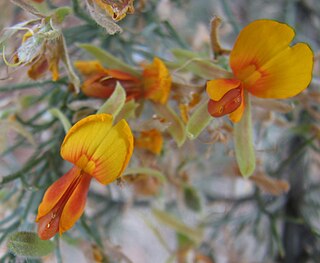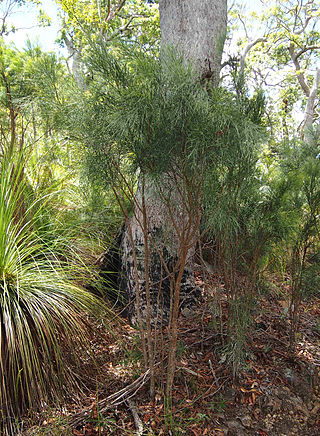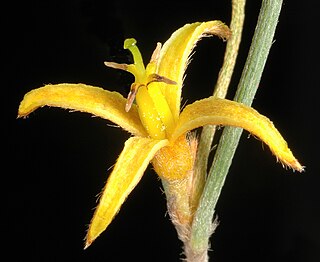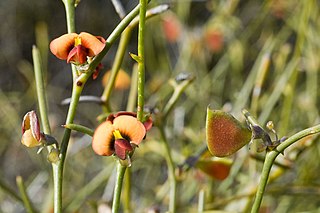
Jacksonia furcellata, commonly known as grey stinkwood, is a species of flowering plant in the family Fabaceae and is endemic to the south-west of Western Australia. It is a prostrate to low-lying, or weeping erect shrub with greyish-green branches, sharply-pointed side branches, its leaves reduced to scales leaves, yellowish-orange flowers, and woody, hairy pods.

Jacksonia scoparia, commonly known as dogwood or winged broom-pea, is a species of flowering plant in the family Fabaceae and is endemic to Queensland and eastern New South Wales. It is a shrub or small tree with angled or winged branchlets, leaves usually reduced to scales, cream-coloured to orange-yellow flowers and oblong, hairy pods.

Eutaxia parvifolia is a species of flowering plant in the family Fabaceae and is endemic to southwestern Western Australia. It is a shrub with reddish brown stems, elliptic to egg-shaped leaves with the narrower end towards the base, and mostly yellow, red or orange flowers, with yellow red or orange markings.

Persoonia angustiflora is a species of flowering plant in the family Proteaceae and is endemic to the south-west of Western Australia. It is an erect shrub with hairy branches and leaves, linear, more or less cylindrical leaves and yellow or greenish yellow flowers arranged singly or in groups of up to four.

Persoonia acicularis is a species of flowering plant in the family Proteaceae and is endemic to the west coast of Western Australia. It is a shrub with linear, sharply-pointed leaves and yellow flowers in groups of up to eighty.

Daviesia hakeoides is a species of flowering plant in the family Fabaceae and is endemic to the south-west of Western Australia. It is a shrub with many tangled stems, scattered sharply-pointed phyllodes and yellow or orange and dark red flowers.
Pultenaea calycina is a species of flowering plant in the family Fabaceae and is endemic to near-coastal areas in the south of Western Australia. It is an erect, spindly shrub with flat or more or less cylindrical, grooved leaves and yellow and orange flowers.
Pultenaea craigiana is a species of flowering plant in the family Fabaceae and is endemic to near Ravensthorpe in the south of Western Australia. It is an erect, spindly shrub with densely hairy young stems, egg-shaped leaves with the narrower end towards the base, and yellow and red flowers.

Pultenaea empetrifolia is a species of flowering plant in the family Fabaceae and is endemic to the south-west of Western Australia. It is a spindly, prostrate or spreading shrub with down-curved, cylindrical, grooved leaves and yellow to orange and red flowers.
Gompholobium karijini is a species of flowering plant in the family Fabaceae and is endemic to the north-west of Western Australia. It is an erect, openly-branched shrub with pinnate leaves with five to ten pairs of leaflets, and racemes of yellow to orange and creamy-yellow, pea-like flowers.

Daviesia arenaria, commonly known as sandhill bitter-pea, is a species of flowering plant in the family Fabaceae and is endemic to south-eastern continental Australia. It is usually a hummock-forming shrub with many short, spiny branchlets and heart-shaped to elliptic phyllodes with a sharp point on the end, and orange-pink, maroon and yellow flowers.

Jacksonia anthoclada is a species of flowering plant in the family Fabaceae and is endemic to the south-west of Western Australia. It is an erect, single-stemmed shrub with hairy, elliptic to egg-shaped phylloclades with sharply-pointed edges, yellow-orange flowers with red markings, and hairy, woody pods.

Daviesia inflata is a species of flowering plant in the family Fabaceae and is endemic to the south-west of Western Australia. It is an erect shrub with many spreading stems, scattered needle-shaped, sharply-pointed phyllodes and orange red flowers with a dark red centre.

Daviesia localis is a species of flowering plant in the family Fabaceae and is endemic to a restricted area of the south-west of Western Australia. It is an erect, spreading shrub with spine-tipped branchlets, scattered, spreading, curved, needle-shaped, sharply-pointed phyllodes and orange-yellow and red flowers with a v-shaped central mark.

Daviesia major is a species of flowering plant in the family Fabaceae and is endemic to the south-west of Western Australia. It is an erect, many-stemmed shrub with scattered, erect, sharply-pointed, cylindrical phyllodes and orange and red flowers.

Eutaxia cuneata is a species of flowering plant in the family Fabaceae and is endemic to the south-west of Western Australia. It is a slender, upright shrub with red and orange pea-like flowers.
Daviesia podophylla, commonly known as buggery bush, is a species of flowering plant in the family Fabaceae and is endemic to the south-west of Western Australia. It is an openly-branched, glabrous, glaucous shrub with many often sharply-pointed branchlets, triangular phyllodes with a sharp point on the end, and orange-yellow, dark red and black flowers.

Daviesia quadrilatera, commonly known as buggery bush, is a species of flowering plant in the family Fabaceae and is endemic to the south-west of Western Australia. It is a robust, erect, glabrous shrub with angular branchlets, vertically flattened, sharply-pointed quadrilateral or triangular phyllodes with a sharp point on the end, and yellow to orange and red flowers.

Daviesia retrorsa is a species of flowering plant in the family Fabaceae and is endemic to the south of Western Australia. It is a dense, tangled shrub with glabrous branchlets and leaves, scattered, needle-like, sharply pointed phyllodes turned backwards, and orange-yellow and red flowers.
Mirbelia balsiformis is a species of flowering plant in the family Fabaceae and is endemic to the far west of Western Australia. It is an erect to sprawling shrub with leaves reduced to triangular scales, and yellow to orange and red flowers arranged in racemes on the side of the branchlets.















